Setting the stage for the Purple Line light rail line to be an overwhelming success: Part 2 | proposed parallel improvements across the transit network
=====
The article series
-- Setting the stage for the Purple Line light rail line to be an overwhelming success: Part 1 | simultaneously introduce improvements to other elements of the transit network
-- Part 2 | the program (macro changes)
-- Part 3 | influences
-- Part 4 | Making over New Carrollton as a transit-centric urban center and Prince George's County's "New Downtown"
-- PL #5: Creating a Silver Spring "Sustainable Mobility District"
- Part 1: Setting the stage
- Part 2: Program items 1- 9
- Part 3: Program items 10-18
- Part 4: Conclusion
- Map for the Silver Spring Sustainable Mobility District
- (Big Hairy) Projects Action Plan(s) as an element of Comprehensive/Master Plans
- Creating the Silver Spring/Montgomery County Arena and Recreation Center
-- Part 6 | Creating a transportation development authority in Montgomery and Prince George's County to effectuate placemaking, retail development, and housing programs in association with the Purple Line
-- Part 7 | Using the Purple Line to rebrand Montgomery and Prince George's Counties as Design Forward
=====
Complementary Improvements Program
triggered by the Purple Line Light Rail Project
Coordinating other transit agency improvements with the opening of the Purple Line. The opening of the Purple Line should be used as a "priming event" to move transit planning, marketing, and operations forward toward the end game of the creation and launch of the DMVTA -- the DC, Maryland, Virginia Transport Association--an integrated transit planning, management, coordination, and operations entity for the DC and Baltimore metropolitan areas.
While changes to bus services are made in association with the opening of rail lines all the time, deeper system improvements are not usually considered in the context of major launch events, and too often, when stations open, communities have failed to make necessary access improvements, especially for pedestrians and cyclists ("People Won't Ride the Tysons Corner Metro If They Can't Walk to Stations," Streetsblog).
In any case, if the following service improvement and integration steps are taken by other transit agencies in advance of but in concert with the launch of the Purple Line system, not only will the Purple Line's success be significant and immediate, the other transit agencies will benefit as well, but most importantly, so will the area's transit riders and jurisdictions.
Below is a pretty detailed set of recommendations for what I consider to be macro scale improvements to the transit network and the sustainable mobility platform in the Washington Metropolitan area.
Although, because the Purple Line will be in Suburban Maryland, the bulk of these recommendations are DC and Maryland focused.
I was going to have a fourth post on micro scale improvements, mostly station access improvements, and things like integrating car sharing, treating stations as "mobility hubs" anchoring transportation management districts, incorporating package pick up and other service amenities in transit centers, etc., but it can wait.
Recommendations
The current Metrorail map.
1. Change the WMATA Metrorail map so that it includes the Purple Line and regional railroad services.
The WMATA map is one of the most iconic graphics depicting Metropolitan Washington, particularly in map form.
It shows railroad connections, but not the actual lines delineating routes of the railroad passenger services.
Changing the map to reflect a coordinated, regionally-scaled transit system will be an important step towards creating such a system.
Map (and service) models for such systems include London, Paris, and major cities in Germany such as Berlin, Frankfurt, Hamburg, and Munich.
Note that without the creation of this proposed program, including the Purple Line on the WMATA map will happen, but not the inclusion of railroad lines.
2. Integrate the Purple Line light rail line into the Metrorail fare system.
I imagine negotiations are underway for this anyway, but it still needs to be said. During the O'Malley Administration, it was the expectation on the part of the Maryland Department of Transportation, that the light rail and subway lines would share an integrated and unified "tolling"/fare system, meaning one fare even if the trip was on both light rail and subway.
Currently, WMATA charges a separate fare for each mode (subway, bus), not one fare per end-to-end trip.
Under that method, rather than treating "light rail" the same as Metrorail, they'd want the PL concessionaire to charge its own fare, but would provide a slight discount to Light Rail riders continuing on via Metrorail.
Rather than operating transit for the benefit of the operator, the system needs to be knit together in ways that benefit riders, in this case by having one unified and single fare framework for trips that combine Metrorail and Purple Line service, even though trips occur across two different agencies.
I expect that a unified single fare based on distance is likely to happen for combined subway+light rail trips irrespective of this proposed program. Note that this is already done for cross-jurisdictional bus transfers between systems (e.g., Ride On to Metrobus, Metrobus to DASH, etc.)
The Baltimore-area CharmCard is merely a prettier version of the "DC-area" SmarTrip card.
3. Integrate MARC fares into the SmarTrip/ CharmCard fare media system.
Regardless of the level of actual coordination, the area's surface transit agencies all use the WMATA SmarTrip fare media card (with a couple of odd exceptions), and the "Regional Bus Pass" allows transfer between bus systems without triggering additional fares.
Called CharmCard, MTA in Maryland uses a separately branded SmarTrip system for local transit services in the Baltimore area. Although they sell their own card, either card works seamlessly in both Baltimore and Washington.
But unlike the fare media systems in Seattle and San Francisco (or the integration of PATH with the NYC Subway fare card), railroad passenger services aren't part of the SmarTrip/CharmCard system.
While it would be best to add both MARC and Virginia Railway Express to the fare media system at the same time, at a minimum, since the Purple Line will connect to all three MARC railroad passenger lines ("One big idea: Getting MARC and Metrorail to integrate fares, stations, and marketing systems, using London Overground as an example"), MARC should be integrated into the SmarTrip fare collection integration before the Purple Line opens. The Purple Line launch becomes the deadline for the change.
4. Introduce bi-directional passenger rail service between DC and Frederick on the MARC Brunswick Line.
Separately I suggested that "corridor management" be implemented in the I-270-Rockville Pike corridor ("Transportation network interruptions as an opportunity: Part 2" and "Transportation network service interruptions part 3: corridor/commute shed management for Northwest DC and Montgomery County, Maryland) and a key element is bi-directional service on the MARC train line between DC and Montgomery County. Such service is recommended in the long range plan for the MARC system.
Currently the service runs in only one direction, from West Virginia/Maryland in the morning, and from DC to Maryland/West Virginia at night.
The opportunity for transit capturing commuting trips is high between DC, Silver Spring, White Flint, Rockville, and Gaithersburg more generally.
When the original service pattern was created for this line, there was limited demand for two-way service throughout the day. Land use has changed significantly in the 60 years since and now Montgomery County is a job destination for many, but the railroad service pattern hasn't caught up.
Use the opening of the Purple Line to set a deadline for the simultaneous launch of bi-directional service on the Brunswick Line.
(Note: because the Camden Line station network doesn't have comparable proximity to major employment and activity centers within Prince George's County, it doesn't present the same kind of opportunity for the creation of an intra-county rapid transit service.)
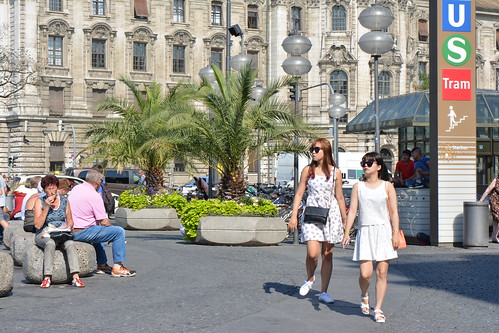 Berlin, Frankfurt, and Munich include trams (light rail/streetcar) in their integrated transit network. Sign showing that Munich's Karlsplatz station has U Bahn (subway), S Bahn (railroad) and Tram service. Flickr photo by westport 1946. (German cities use the same U and S logos to denote services across their transit networks.)
Berlin, Frankfurt, and Munich include trams (light rail/streetcar) in their integrated transit network. Sign showing that Munich's Karlsplatz station has U Bahn (subway), S Bahn (railroad) and Tram service. Flickr photo by westport 1946. (German cities use the same U and S logos to denote services across their transit networks.)5. Consider charging DC-Montgomery County trips on a bi-directional Brunswick Line using the Metrorail/Purple Line tolling/fare schedule. That would treat mileage from railroad trips in the context of a complete (linked) trip on railroad+subway+light rail as a single fare.
In Germany, "suburban railroad passenger services" are organized as the S-Bahn, and operated as a form of "local rapid transit" where trip pricing is based on zones or the distance traveled, integrated with subway service (similar services exist in other European countries, and in cities such as with the London Overground and the Paris RER system).
This is not the case in the US, although Transport Politic suggested years ago ("Expanding Transit Access to Southeast Queens") that transit service for a particularly underserved part of Queens could be significantly improved by better leveraging certain lines of the Long Island RR including adding stations, and adopting rapid transit style pricing for these trips. (The comment thread also has additional suggestions and recommendations that are quite interesting.)
Peak fares on Metrorail are comparable to MARC fares, although off-peak fares to places like Rockville or Silver Spring are significantly less on WMATA than on MARC.
Maybe it's too much to ask for off-peak MARC fares equal to Metrorail fares for the "DC-Montgomery County" zones on MARC, but at the very least, MARC rides could be integrated into the expected Metrorail/Purple Line unified tolling/fare schedule, and a railroad+subway+light rail trip would incur a single fare, not three different fares for one end-to-end trip.
6. The White Flint Sector Plan calls for an infill MARC station. Plans to build that station should be accelerated as part of this proposal.
Note that in Boston, New Balance paid for a new MBTA railroad station as part of the development of the Boston Landing complex, which includes the company's headquarters, a practice facility for the Boston Bruins, and other commercial and residential properties ("New Balance bought its own commuter rail station," The Atlantic).
The station (rendering above) will cost about $16 million to build and New Balance has agreed to pay the station's operating costs for at least 10 years. The station will open in May.
With bi-directional service on the Brunswick Line between DC and Frederick, likely the various development interests behind the redevelopment of White Flint could come up with the money for the station. Baring that, a "public improvement district" could be created to fund it (more about that concept later).
7. Build an infill train station in DC on the Penn Line, serving the New York Avenue corridor. This is recommended in the DC State Rail Plan and I've written about it in the past, coming around to the idea after originally being skeptical. It makes a lot more sense as part of an integrated rail transit network, rather than adding a station on what is otherwise a commuter rail line, in an area without significant employment centers. [Note: this recommendation was added to this list on 8/2/2017, with the subsequent renumbering of the following entries.]
The reason to do this on the Penn Line, not the Camden Line, is that it has 7 day service, with hourly service in off-peak periods, til about 10 pm. Although it will require a special agreement between DC and Maryland, as currently DC is not a "member" or partner in providing MARC service.
Like with the recommendation in point #5 on creating an integrated tolling system for fares between MARC, Metrorail, and the Purple Line as it relates to the proposed bi-directional service between Frederick and DC (recommendation #4), a similar program should be set up for trips between the proposed New York Avenue Station and Union Station and maybe between the infill station and New Carrollton (although to MARC this would be a normal $5 trip).
If this occurs in association with the merger of the MARC Penn Line and the VRE Fredericksburg Line (recommendation #14, below), it would be even more beneficial, but would require changes to the tolling schedule for MARC and Metrorail between New York Avenue and probably as far as Alexandria.
8. Provide integrated train arrival information screens at Metrorail, Light Rail, and MARC stations.
One of the problems that results from having different agencies doing different things is that there isn't one integrated system that presents bus and train arrival information across the "transit network."
 The TransitScreen display at the Silver Spring Civic Center.
The TransitScreen display at the Silver Spring Civic Center.WMATA has six different transit information programs (the screens on the train platforms, a different set of screens at station kiosks and occasionally on station platforms, a system for bus information at the Silver Spring Transit Center, a non-screen based bus information system at the Takoma Langley Crossroads Transit Center, new advertising-based program with Outfront Media in Metrorail stations, and a bus shelter system similar to the train platform program).
Arlington County has a different program that integrates information from different mobility operators, Montgomery County uses a similar application, produced by TransitScreen, and DC has a similar digital application.
What distinguishes WMATA's information presentation programs is that they don't provide information for other agencies (except at SSTC and at the TLCTC), but there is not one integrated arrival-departure board anyway).
With integration of Metrorail and the Purple Line at four stations (Bethesda, Silver Spring, College Park, and New Carrollton) and the integration of the Purple Line at three MARC stations (Silver Spring, College Park, and New Carrollton), arrival and departure information for all three rail services should be presented in a common system, across all the separate mode platforms, so that a rider on Metrorail knows when the next PL train is arriving, etc.
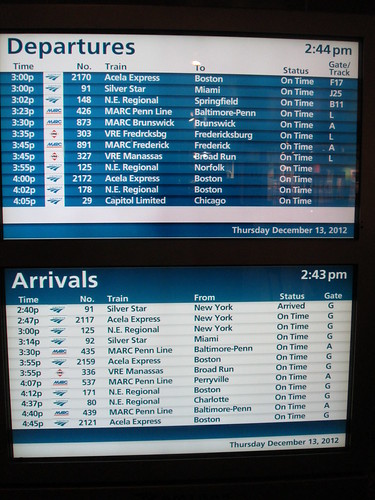 Arrival and departure screens at Union Station. Flickr photo by John Corbett.
Arrival and departure screens at Union Station. Flickr photo by John Corbett.Ideally, it would be on one screen board, the way that at Union Station, "Amtrak" screens show information for MARC and VRE as well.
Baring that, the TransitScreen format, which provides information for multiple services, but in separate sections of the same screen, would be acceptable.
9. Provide integrated bus arrival and departure information screens at Metrorail, Light Rail, and MARC stations.
In keeping with the previous recommendation, a similar integrated information system should be provided for bus services, as most stations have two to four different providers.
In this TransitScreen display, Metrobus information is presented in blue, and the DC Circulator bus information is presented in red.
A big issue is providing information for all the different services in one application, rather than different screens for different agencies.
10. Bus service in certain corridors between DC and Maryland should be extended and/or frequency increased to better link these areas to the new light rail service.
Many of the area's bus services terminate at the city-state line, although there are some exceptions. DC and Maryland should commit to bus service improvements in advance of the PL launch.
(a.) On Wisconsin Avenue, the 30s bus should be extended from Friendship Heights to Bethesda (and potentially to Medical Center). (b.) The DC L2 line should be extended up Connecticut Avenue at a minimum to the Chevy Chase Lake Light Rail Station. (c.) The Georgia Avenue (70s) and 16th Street (S) lines already extend to Silver Spring, and Q and Y buses travel within Montgomery County along the Georgia Avenue corridor. (d.) The K6 bus already travels from Fort Totten to White Oak on New Hampshire Avenue. This line will serve the Takoma Langley Crossroads Station at University Boulevard when the PL opens.
 (e.) The R1 bus serving the Riggs Road corridor north from Fort Totten will serve the Riggs Road-University Boulevard Light Rail Station.
(e.) The R1 bus serving the Riggs Road corridor north from Fort Totten will serve the Riggs Road-University Boulevard Light Rail Station.(f.) In the Rhode Island Avenue corridor the Purple Line will serve the University of Maryland campus and will connect to the MARC Camden Line and the northern leg of the Green Line at College Park. There are various Metrobus services on part or all of the corridor, as well as the Route 1 Ride service from Prince George's County. These services should be combined into one integrated and branded service.
11. Montgomery County bus system improvements with the launch of the Purple Line and bi-directional service on the MARC Brunswick Line should include launch of planned Bus Rapid Transit services.
Like any good transit agency, MCDOT is already planning to rationalize and extend service in various ways in association with the opening of the light rail system, just as they did with the opening of the Red Line.
Besides those changes, they should commit to the opening of the Route 29 BRT service, with consideration of a New Hampshire Avenue leg terminating at either the Takoma Langley Station at University Boulevard or at Fort Totten Metrorail station in DC.
This would combine elements of two different lines as currently planned. The Route 29 Line is shown as green on the map below, while the New Hampshire Avenue Line is shown as red.
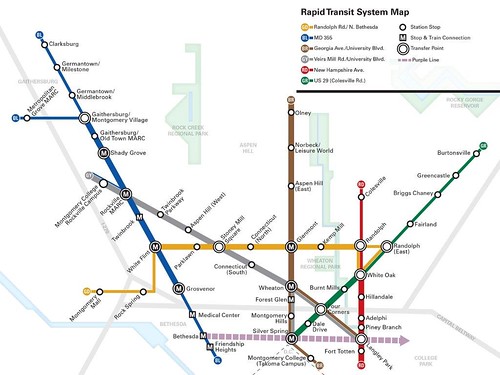
Map of the proposed BRT system produced by Dan Malouff for the Coalition for Transit.
Flickr photo by MW Transit.
12. Rearticulate, rebrand, and reposition-extend the Prince George's County TheBus bus transit service. Change the name of the service and the graphic design of the bus livery.
For many years I have suggested that Prince George's County has been given a second chance to reposition its land use and transportation planning paradigm around transit rather than automobility--they didn't do so in association with the original Metrorail system. Despite changes in rhetoric which now favors "transit oriented development," the County's development priorities tend towards sprawl-promoting projects such as National Harbor and Konterra.
They have the same opportunity for rearticulation with their complementary local transit system. Currently, TheBus system is the least well developed of the suburban transit agencies ("By choosing coverage over frequency, Prince George’s caps what its buses can accomplish," GGW).
In association with service expansion and improvement concomitant with the opening of the Purple Line, PG Department of Public Works and Transportation should commit to a rebranding and redesign of the bus system, which currently isn't very design forward.
 In the Raleigh-Durham metropolitan area, all but one of the bus systems has agreed to use a common brand, GoTransit, and design, with a specific color assigned to each system, to distinguish it from the others.
In the Raleigh-Durham metropolitan area, all but one of the bus systems has agreed to use a common brand, GoTransit, and design, with a specific color assigned to each system, to distinguish it from the others. 13. Consider a redesign and rebranding of the the metropolitan area's bus systems into an integrated framework, comparable to that of GoTransit in the Raleigh-Durham area.
This has been discussed in depth here, "Will buses ever be cool? Boston versus the Raleigh-Durham's GoTransit Model." This gives a deadline for launch.
From the presentation ("The Sign Design Society Event: Defining a City," designworkplan) by Ivan Bennett, Design Manger for London Buses:
One reason other systems have failed is the lack of continuity. London bus stops extend beyond central areas and cover all routes in Greater London. Ivan indicated that passengers do not just want information about where they are travelling from, but when they get there, they need the same consistently presented information. People need information near their homes and local areas, not just in the centre of the city.Ideally, a rebranding of the PG County bus system would occur as part of an overall metropolitan-scale process.
As would the creation of a unified integrated customer service center for all of the transit agencies.
14. Set the opening of the Purple Line as the deadline for the integration of the MARC Penn Line and VRE Fredericksburg Line into one combined railroad passenger service.
This is discussed in depth here, "A new backbone for the regional transit system: merging the MARC Penn and VRE Fredericksburg Lines." The merged line would connect to the PL at New Carrollton Station. This puts a deadline for the launch of this concept.
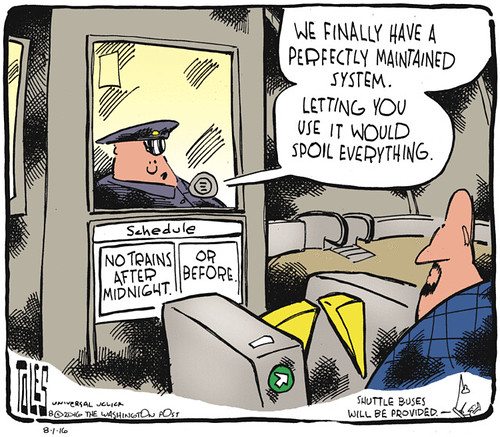
Tom Toles editorial cartoon, 8/1/2016, late night transit service.
15. Set the opening of the Purple Line as the deadline for the implementation of a full-fledged integrated Night Owl bus network for the DC metropolitan area.
San Francisco Bay late night bus service transit map.
This is discussed in depth here, "Night and weekend transit/subway service," "Overnight transit service: San Francisco," and "Night moves: the need for more night time (and weekend) transit service, especially when the subway is closed.
This puts a deadline for the launch of this concept.
16. Create a cheap weekend pass to use the local transit network, especially Metrorail.
Right now, weekend subway service is abominable. No wonder ridership has declined so precipitously.
In association with the eventual fixing of the system to a state of good repair and the launch of the Purple Line as a way to rearticulate and integrate transit service and improvements to the transit network, the DMVTA and in particular Metrorail+Purple Line Light Rail should implement a cheap weekend pass.
The model is Melbourne. On weekends and public holidays the equivalent of a full day transit pass is $6. A WMATA Day Pass is $14.50.
Note that Melbourne has other fare programs focused on transit encouragement rather than revenue generation. The night-time fare is $4.10 total from 6 pm to 3 am, and if you ride transit early in the morning and your end-to-end trip finishes before 7:15 am the trip is free.
This is more about rewarding riders for putting up with service degradation for many many years, but why not do it?
17. Incorporate quantum improvements in bicycle facilities across the mobility network in association with the launch of the Purple Line.
With the exception of some bike parking, the opportunity was missed to include significant bicycle accommodations in the new Takoma Langley Crossroads Transit Center ("TLCTC: a critical evaluation").
The Purple Line will include an upgrade of the current Capital Crescent Trail, and is supposed to include a cycle track on University Boulevard. Bike parking is planned for the stations.
(a.) Treat Metrorail, PL, and MARC stations as "trailheads" for the bicycle transportation network. Besides including air pumps and repair stands at PL stations, which is still not standard practice for transit stations in the region;
(b.) jurisdictions should work to complete various area bicycle trail projects with the deadline being the launch of the Purple Line, examples being the Metropolitan Branch Trail in DC, and the connector from Fort Totten in DC to West Hyattsville station, in Prince George's County, as well as the Central Avenue Connector in Prince George's County, which won't connect to the Purple Line, but why not use the launch as an excuse to move the project forward ("Comments on the Central Avenue Connector Trail concept (Prince George's County, Maryland").
.
(c.) simultaneous with the launch of the Purple Line should be the creation and printing of a "Metropolitan Bikeways Network" map and it should be posted in Metrorail, MARC, VRE, and Purple Line stations.
(d.) Create bike hubs as needed at PL/Metrorail stations. WMATA has developed some secured parking stations, but not multifaceted "bike hubs." Ensure that the bike hub planned for Silver Spring opens simultaneously with the PL.
A new model to consider is the Los Angeles MTA's Bike Hub program. The first was at the El Monte Regional Bus Station, which is the largest local transit bus station outside of the East Coast and Chicago ("A parking garage for bicycles just opened at El Monte Bus Station," San Gabriel Valley Tribune).
Velofix is a mobile bike repair operation, with franchises across North America.
Bike hubs could be the touch point for the delivery of programs like a bike co-operative, youth programs, "create a commuter" programs, and cycle loan schemes to assist people in trying out cycling for transportation.
Work with mobile bike repair operations and/or local bike shops to create a regular schedule of on-site bike repair options at transit stations.
(e.) Develop an integrated secure bike parking program across the region, anchored by the transit network, modeled after the Parkiteer program in Victoria State, Australia. Centered on Melbourne, this is a network of 90+ secure bicycle parking cages at railroad and transit stations.

Bayswater Station, Melbourne, Parkiteer Bicycle Parking Cage
A cross-network bike parking system should include:
- key activity centers, not just transit stations. With the opening of the Purple Line, parking authorities in Montgomery and Prince George's should commit to participating;
- not just bike cages like the Parkiteer program, but a wide variety of high quality secure bicycle parking options designed according to the location's conditions, opportunities, and potential for the most cost-effective installation.
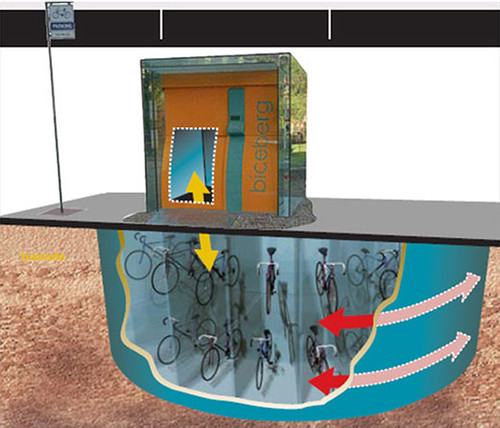
The Biceberg underground bicycle parking system works with an above-ground kiosk.
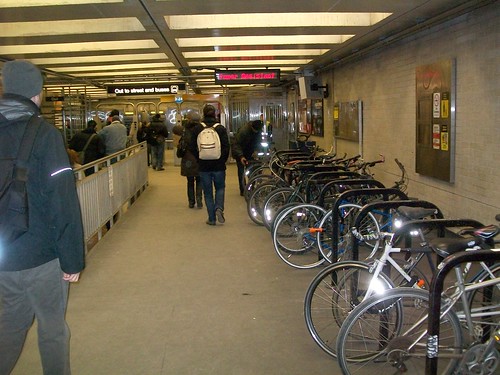
At the Logan Square CTA station in Chicago, protected bike parking is available within the station, behind the fare gates, in interstitial space.
Note that the Biceberg has the capacity of 23, 46, 69, or 92 bikes, depending on the underground configuration (each unit of 23 equals the cubic feet of one parking space), while the bike cages used in the Parkiteer program have a capacity of 30.
18. Rearticulate transportation demand management programming and services in conjunction with the PL launch, including a single network of "customer information centers."
Arlington was the first jurisdiction in the area to launch "Commuter Stores," promoting alternatives to driving alone, in particular transit. Other jurisdictions including Montgomery County have similar programs.
PG County does not, and there are gaps in the MoCo program, for example the office at the Silver Spring Transit Center is poorly located and it isn't open on weekends.
If the metropolitan area's bus agencies were to adopt a common branding system, the name, logo, design, etc. could be extended to TDM stores.
19. WMATA should upgrade its Metrorail station bus shelters.
Another aspect of the balkanized transit system in the DC area is that every jurisdiction has a different program for bus shelters--what Ivan Bennett, product design manager for the London bus program, calls "a lack of continuity."
Metrobus isn't responsible for shelters in the various jurisdictions, although WMATA does have bus shelters on the grounds of many Metrorail stations outside the core.

Bus shelters at the Medical Center Metrorail Station.
Unfortunately, the Metrorail station shelters are dowdy, don't incorporate real-time arrival and departure information, could include advertising as a revenue stream, etc.
Why not use the launch date of the Purple Line as an inducement and deadline for an overhaul of the Metrorail bus shelters across the station network?
... although this doesn't address the fact that in an integrated bus service branding system across the jurisdictions, ideally, there would be a common set of transit shelters and amenities across the transit network.
-- Transit Waiting Environments, for the Greater Cleveland Rapid Transit Authority
-- From Here to There: A creative guide for making public transport the way to go, EMBARQ
-- Rethinking the Suburban Bus Stop, Airport Corridor Transportation Association, Pittsburgh
-- First/Last Mile Strategies Study, Utah Transit Authority
The Kansas City Streetcar Smart City "City Post" digital kiosks include a real-time tracker application for the streetcar service ("No need to wonder where streetcar is: Kiosks now offer tracker maps," Kansas City Business Journal). Photo: Andrew Grumke.
20. Create "sustainable mobility" corridors in Silver Spring (and other places), complementing the new PL.
This concept is something I've been meaning to write about since last summer, as part of a broader set of writings on transportation infrastructure and civic architecture ("Transportation infrastructure as a key element of civic architecture/economic revitalization #1: the NoMA Metrorail Station," "Public improvement districts ought to be created as part of transit station development process: the east side of NoMA station as an example," and "Transportation Infrastructure and Civic Architecture #3: Rhode Island Avenue Pedestrian Bridge to the Metrorail station") and at some point within the next month I'll write a dedicated piece about it.
In Silver Spring, Wayne Avenue and Fenton Street would be targeted for this treatment. Undoubtedly, other streets in the transit shed of the Purple Line are equally deserving.
The idea was sparked by complaints by citizens at a public meeting not happy about the PL not being undergrounded on Wayne Avenue. My response was that at some point, when it comes to urban design-related improvements, the costs need to be borne by the locality, not the transit authority.
But at the same time, why not make the street great in association with the transit project. (This is also an issue with the extension of the DC Streetcar further into Ward 7 on Benning Road.)
The idea is to apply my "Signature Streets" concept (see the discussion in "Town-city management: we are all asset managers now") and some of the elements introduced along with some of the street-side improvements associated with the Kansas City Streetcar implementation (digital kiosks, wifi, public art, etc.) and concepts in two books, the Transit Street Design Guide published by Island Press and Street Design: The Secret to Great Cities and Towns, published by Wiley.
More recently, MoCo's Energized Public Places planning initiative has influenced this recommendationt too, specifically with regard to Fenton Street.
The TfL Healthy Streets initiative aims to develop metrics on ten different criteria for developing plac-oriented street improvement projects.
Note that the Transport for London Healthy Streets Initiative provides some important concepts that can be harvested for development of the Signature Streets concept (see "Transport for London's "Healthy Streets" approach integrates place and aesthetics considerations alongside mobility").
Labels: busways/transitways, change-innovation-transformation, fixed rail transit service, public realm framework, transit, transit marketing, transportation planning, urban design/placemaking















6 Comments:
This column in the Boston Globe discusses potential cuts in weekend passenger rail service, making the point that the transit system is "world class" only five days/week.
https://www.bostonglobe.com/opinion/2017/03/15/world-class-city-five-days-week/LBdlDQjygYHkVFf1LSiXYM/story.html
This piece by Toronto Star columnist Edward Keenan makes the point that station use is maximized by connections (bus, streetcar, etc.) to the particular station, and that stations with more connections have more users than stations with few or no connections.
That development around the station is a different issue in terms of generating usage.
https://www.thestar.com/news/gta/2017/10/17/heres-how-to-make-the-lawrence-east-smarttrack-station-a-success-keenan.html
an example of the need for more multimodal planning/station area planning, at the proposed West Station commuter rail station for the Allston district of Boston, part of the proposed Harvard-initiated redevelopment of that area.
https://www.bostonglobe.com/opinion/letters/2018/01/21/mass-needs-vision-for-allston-project-that-eyes-regional-transit/QLBX4L8ChsuKh3Wpkqjj5K/story.html
Separately, BU advocates for the station to be connected to their Longmont Medical Center via a dedicated busway.
https://www.bostonglobe.com/business/2018/02/09/wants-west-station-but-isn-saying-what-will-pay/7gWuSq6YP2OkggFbruErWO/story.html
septa modern trolley station design guide
https://www.dvrpc.org/Reports/15014.pdf
is relevant to station design.
11/19/2023
12. Rearticulate, rebrand, and reposition-extend the Prince George's County TheBus bus transit service. Change the name of the service and the graphic design of the bus livery.
----
Prince George's County is improving their bus system.
https://www.nbcwashington.com/news/local/greater-reliability-changes-coming-to-prince-georges-county-bus-system/3456917/
10/30/23
Including electric buses, the PGC Connect app, with real time information on bus arrival, amenities on the buses including USB charging and digital screens communicating information, and changes to routes and scheduling to improve efficiency.
https://www.princegeorgescountymd.gov/departments-offices/news-events/news/prince-georges-county-celebrates-official-launch-transit-transformation-proud-priority-event
Transit Vision Plan (TVP): Aims to comprehensively review the current transit system (paratransit, T-transit, and bus network) and provide recommendations to improve transit service throughout Prince George’s County over the next five years. The plan will be completed by Summer 2024.
Transit Forward: A new and innovative approach analyzing the quality, effectiveness, and delivery of TheBus services. Using data and community feedback, the County is moving transit forward by prioritizing the performance of the services we provide. The approach is designed to evaluate operational processes, transit facilities and amenities, and the customer experience.
Zero-Emission Bus (ZEB): Prince Georgians deserve cleaner air, quieter buses, and improved energy infrastructure. The County is excited to transition nearly 70% of the fleet to zero emissions by 2035 and 100% by 2040. Transitioning to zero-emission requires the County to invest in green, resilient energy resources while updating facilities and infrastructure. ZEB ties into core values of equity and sustainability.
Service Changes: The service change process allows DPW&T to assess transit services bi-annually. Following a data-focused approach and a deep look at transit operations, the Department will implement a major fall service change in December 2023. The transit service changes include maximized travel time savings and improved quality of service for customers.
https://pgc-transit-transformation-princegeorges.hub.arcgis.com/
https://www.riderta.com/sites/default/files/events/2025-01-07LightRailShelterReplacementPresentation.pdf
The Light Rail Shelter Project is intended to increase ridership by improving comfort, convenience and service through new shelters, lighting, informational signage, seating, bicycle parking and landscaping, the transit agency said. As part of the project, three contracts will be awarded for shelters, construction and real-time digital arrival signs.
Twenty-eight of the 36 shelters will be placed along the Blue and Green light rail lines, and eight will be placed at connecting bus routes.
Post a Comment
<< Home